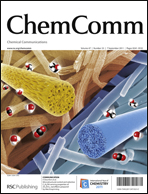Resonance light scattering as a powerful tool for sensitive detection ofβ-amyloid peptide by gold nanoparticle probes†
Abstract
A novel biosensing strategy has been developed for sensitive detection of β-amyloid 1–42 (Aβ1–42) down to the ng mL−1 level in both aqueous solution and diluted human plasma, which is based on measuring changes in resonance light scattering of streptavidin functionalized


 Please wait while we load your content...
Please wait while we load your content...